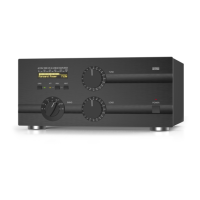a) GND stud
First, connect the wing-nut grounding stud of the amplifier (on the rear panel, marked GND) to the
station's grounding system (see Figure 2-1 Rear panel - Connections, Pos. (a)).
WARNING
Note that the grounding system may have to withstand currents over 20 A with
insignificant voltage drop on it. Therefore, it may be necessary to improve it
considerably, i.e., to become less resistive, with heavier leads and lower-resistive
ground path. The grounding leads should be at least 8 mm² (AWG 8 or SWG 10).
b) RF INPUT socket
Connect a suitable coaxial cable from the transceiver output to the amplifier RF INPUT SO-239 socket (see
Figure 2-1 Rear panel - Connections, Pos. (b)), using PL-259 plug.
NOTICE
In order to avoid a damage, turn off your transceiver's internal antenna tuner.
c) RF OUTPUT socket
NOTICE
If this is the first time you will use a power amplifier in your station, pay attention to the
coaxial cable type from the amplifier's output to the antenna. It must handle the
increased power safely, particularly on the 10- and 6 meters bands. We recommend
that you use RG213 cable or better. Check the same for the antenna selector and tuner
as well as the antenna itself (especially multi-band trap antennas).
Connect a suitable coaxial cable with a PL-259 plug from the amplifier RF OUTPUT (see Figure 2-1 Rear panel
- Connections, Pos. (c)) to the antenna selector or tuner, or to the antenna for the respective frequency
band.
d) KEY-IN socket
This is the amplifier's input for receive/transmit control from the transceiver.
The transceiver controls the amplifier from receive mode into transmit mode (RX/TX) by grounding of the
KEY-IN input.
Run a shielded cable from the "ground on transmit" socket or terminal on your transceiver to the amplifier
KEY-IN socket (see Figure 2-1 Rear panel - Connections, Pos. (d)). The KEY-IN socket uses a standard RCA
phono plug.

